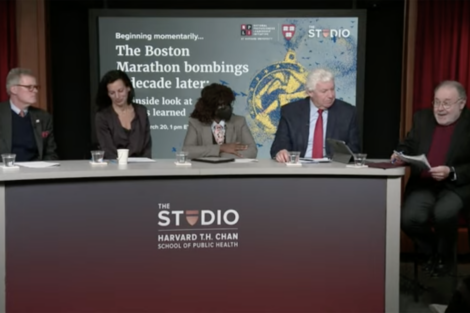March 22, 2023 – Rich Serino had spent all day on April 15, 2013, at the finish line of the Boston Marathon, monitoring it as deputy administrator for the Federal Emergency Management Agency. He’d just left to speak at a class at Harvard’s Kennedy School of Government when he got the news that there’d been a bombing at the finish line, with two homemade explosives ripping through the crowds of bystanders. He raced back to the scene along with Juliette Kayyem, a senior lecturer on national security and CNN commentator whose class he was attending.
This past week, Serino, now a Distinguished Visiting Fellow at Harvard’s National Preparedness Leadership Initiative (NPLI), and Kayyem participated in a panel discussion at Harvard T.H. Chan School of Public Health that focused on lessons learned in the wake of the tragedy. Other panelists included S. Atyia Martin, who was director of the Boston Public Health Commission’s Office of Public Health Preparedness at the time; Eric McNulty, associate director of NPLI; and Leonard Marcus, founding co-director of NPLI. “It is incumbent upon us to reflect on the lessons that can be learned from such shocking events so that the learning serves to save lives, support responders, and potentially even prevent such events in the future,” said Marcus, who moderated the panel.
Three people lost their lives in the bombing; Amazingly, however, all of the hundreds of wounded who made it to the hospital survived—an unprecedented outcome for such a disaster. That was no accident, said Serino, who pointed to the years of training before the marathon that resulted in proper emergency equipment onsite, best practices such as use of tourniquets, and a communication plan aimed at distributing people evenly to different hospitals. In 2009, Boston had sponsored a meeting of leaders in disaster preparedness from around the world, retooling many of the city’s practices based on that gathering.
In addition, said Martin, event planners and medical leaders have traditionally used the marathon itself as an annual occasion to test protocols and systems that would be involved in potential disasters. “We always perceived the marathon as a way for us to test our ability to respond,” said Martin, now CEO of All Aces, which works with companies to confront institutional racism. In some ways, said Kayyem, the ubiquitous slogan of “Boston Strong” in the aftermath of the bombings obscured the amount of advance planning that bolstered the response. “It sort of sells us short,” Kayyem said. “It makes it sound like, we’re tough people, but it’s actually all the planning that was going on that made us strong.”
Immediately after the bombing, the response was aided by an exemplary level of coordination between agencies, said McNulty, who has studied the marathon as a positive example of what he’s termed “swarm leadership.” There was “no ego and no blame,” he said. “The leaders we talked to quickly realized they were going to succeed or fail together.” The bombing was notable for what he called the “unity of mission” between everyone from Boston police chief Ed Davis, to the bystanders helping the injured, to the runner who crossed the finish line and kept running to Mass General Hospital to donate blood. “Everyone was focused on saving lives,” McNulty said.
Leaders, meanwhile, worked behind closed doors to regulate their emotions and get on the same page to present a unified front to the public. It certainly helped, Kayyem noted, that personal relationships had been built up in advance, with a trust between Boston Mayor Tom Menino, Governor Deval Patrick, and President Barack Obama, all Democrats who had worked together cooperatively in the past. Officials set up a Family Reunification Center to connect runners—who often were without phones or IDs—with family members; made sure hospitals had supplies for amputations, a rare procedure; and coordinated with National Guard soldiers to check backpacks at MBTA stations.
The marathon bombing response was successful not only in the immediate aftermath of the disaster, but also in the follow-up, the panel’s participants said. Ken Feinberg, who managed compensation for victims of 9/11, recommended setting up one place for money to go and that it be distributed quickly to take care of the medical bills and expenses of those affected by the bombing—which is how the One Fund was born. At the same time, officials set up a Family Assistance Center in the Boston Seaport that brought agencies including the Red Cross, the Department of Homeland Security, and the Attorney General’s Office of Victim Assistance into one place to provide support for victims and their families, along with updates on the criminal investigation into the perpetrators of the attack.
Finally, said Serino, special care was paid to the bystanders and emergency medical staff who ran into the fray to help victims. “People were able to do, as they say, the right thing, but it came at a cost,” Serino said. Mental health services were offered not only to victims, but also to responders to deal with the trauma of the event—an innovation, said Marcus, that has now become more standard in disaster response over the past decade.
All of the panelists agreed that, 10 years after the event, the disaster response should be more widely studied and adopted in other disaster situations. “There’s so much depth,” said McNulty, “to all of the work that we’ve done behind the scenes that’s not widely known. If we’re going to carry this forward and have better outcomes in other incidents, be they bombings or hurricanes or whatever, we’ve got to learn these lessons.”
– Michael Blanding
